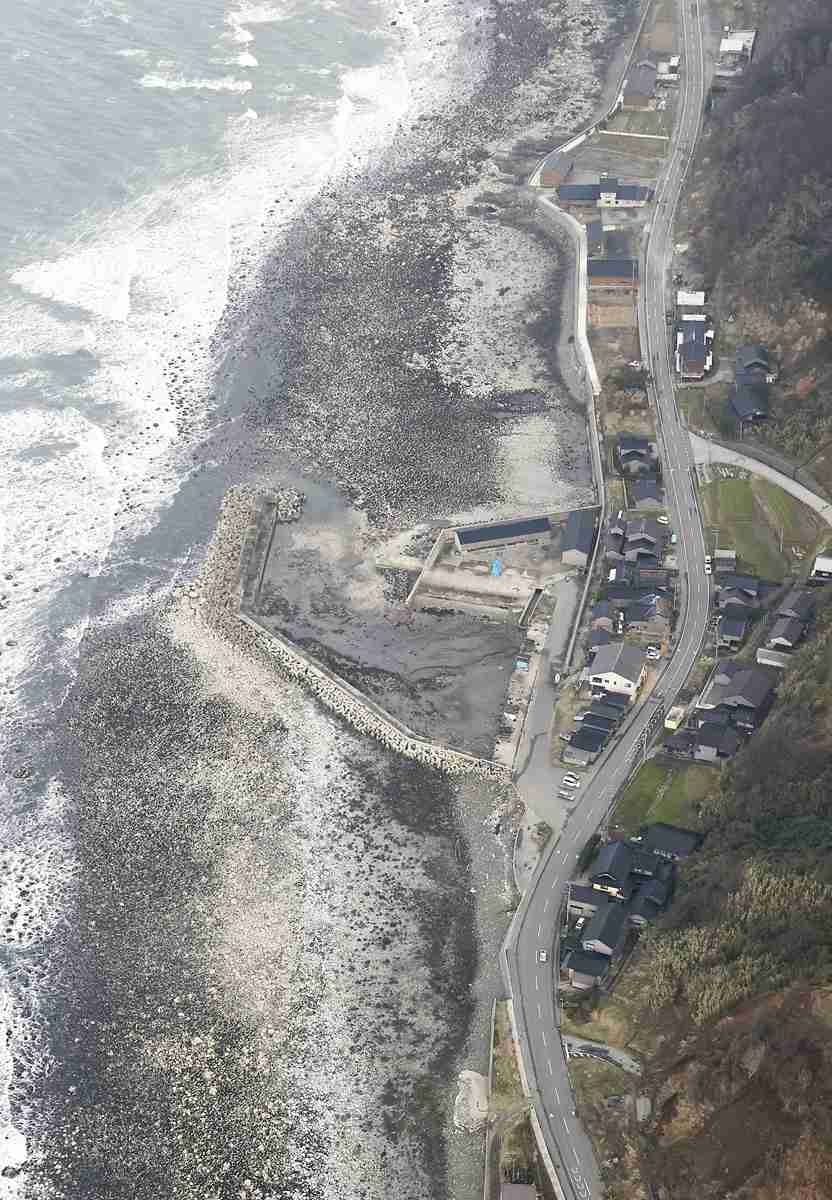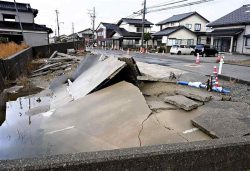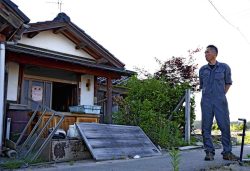
Ground uplifted and seabed exposed in an aerial photo of Nagahashi Port in Suzu, Ishikawa Prefecture, on Saturday
17:39 JST, January 11, 2024
The Noto Peninsula Earthquake has caused serious damage to the fishing industry.
According to Ishikawa Prefecture, more than 50 fishing ports were damaged by ground uplift among other factors, and at least 145 fishing boats were capsized, sunk or stranded by the tsunami. An assessment of the damage is ongoing, and the actual damage may be more extensive than currently reported.
In Nanao City, one of the leading farm-raised oyster producers in the Sea of Japan that hauls Noto-brand oysters, 14 ports suffered damage to wharves and other facilities.
A 28-year-old oyster farmer took his boat out to the sea two days after the quake and saw the sea had turned brown and muddy. Bamboo oyster racks had also been bent or washed away.
The oysters, raised for one to two years before shipment, fell from the racks and sank to the bottom of the sea, getting covered in mud.
The clams would have brought him a revenue of about ¥100 million had they been shipped. Both distributors and staff have been affected by the quake, and most of the remaining oysters have not been shipped out.
“We have had disasters in the past, but the magnitude of the damage this time is far beyond anything we have ever seen before,” he said.
Fishermen made reports such as “ropes to secure oysters to racks were cut off” to the Nanao Western Bay Fishery Cooperative Union, which comprises of about 40 groups of farmed oyster growers and dealers.
According to the prefectural fisheries cooperative, in-season yellowtail fishing was also affected by the quake. In Nanao, Suzu and elsewhere, loading docks and ice-making facilities in markets were damaged. Poor road conditions affect logistics.
Although operations have partially resumed, a person in charge at the cooperative said: “We are having trouble making ice for transporting yellowtail because of damaged ice machines and water outage. We want to maintain operations as much as possible.”
According to the prefectural government, many boats sank and fishing gear were damaged, bringing grave consequences to the livelihoods of people in the fishing industry. Damaged ports will require extensive restoration work.
At Wajima Port, roads swelled and boats ran aground one after another, possibly due to the quake-triggered uplift of the seafloor. Wajima is known for its wild blowfish and high-end nodoguro blackthroat seaperch.
“It’s pretty tough not being able to go to sea for a long time,” a 64-year-old local fisherman said.
The prefectural government has opened a support center for fishermen as they also hasten to assess the scale of damage.
Gov. Hiroshi Hase said, “We will focus our efforts on assessing the damage, providing consultations and financial assistance.”
"Society" POPULAR ARTICLE
-

M4.9 Earthquake Hits Tokyo, Neighboring Prefectures
-

M7.5 Earthquake Hits Northern Japan; Tsunami Waves Observed in Hokkaido, Aomori and Iwate Prefectures
-

Tsukiji Market Urges Tourists to Avoid Visiting in Year-End
-

Israeli Tourists Refused Accommodation at Hotel in Japan’s Nagano Pref., Prompting Protest by Israeli Embassy and Probe by Prefecture
-

M5.7 Earthquake Hits Japan’s Kumamoto Pref., Measuring Upper 5 Intensity, No Tsunami Expected
JN ACCESS RANKING
-

Keidanren Chairman Yoshinobu Tsutsui Visits Kashiwazaki-Kariwa Nuclear Power Plant; Inspects New Emergency Safety System
-

Imports of Rare Earths from China Facing Delays, May Be Caused by Deterioration of Japan-China Relations
-

University of Tokyo Professor Discusses Japanese Economic Security in Interview Ahead of Forum
-

Japan Pulls out of Vietnam Nuclear Project, Complicating Hanoi’s Power Plans
-

Govt Aims to Expand NISA Program Lineup, Abolish Age Restriction
























